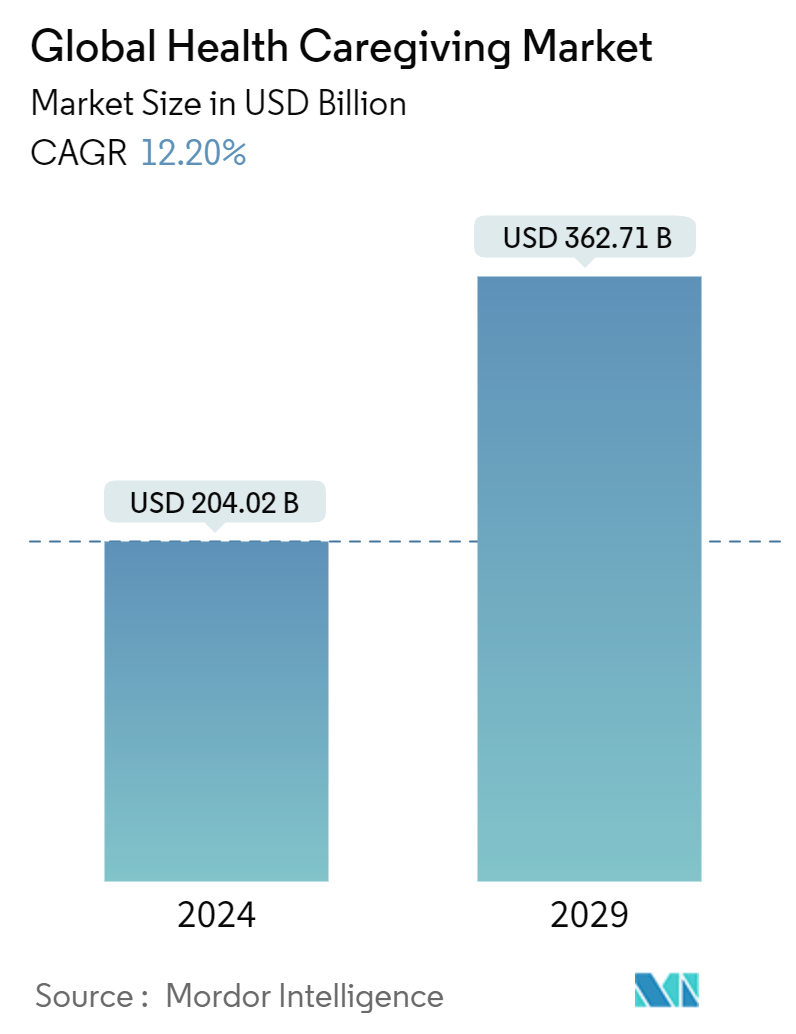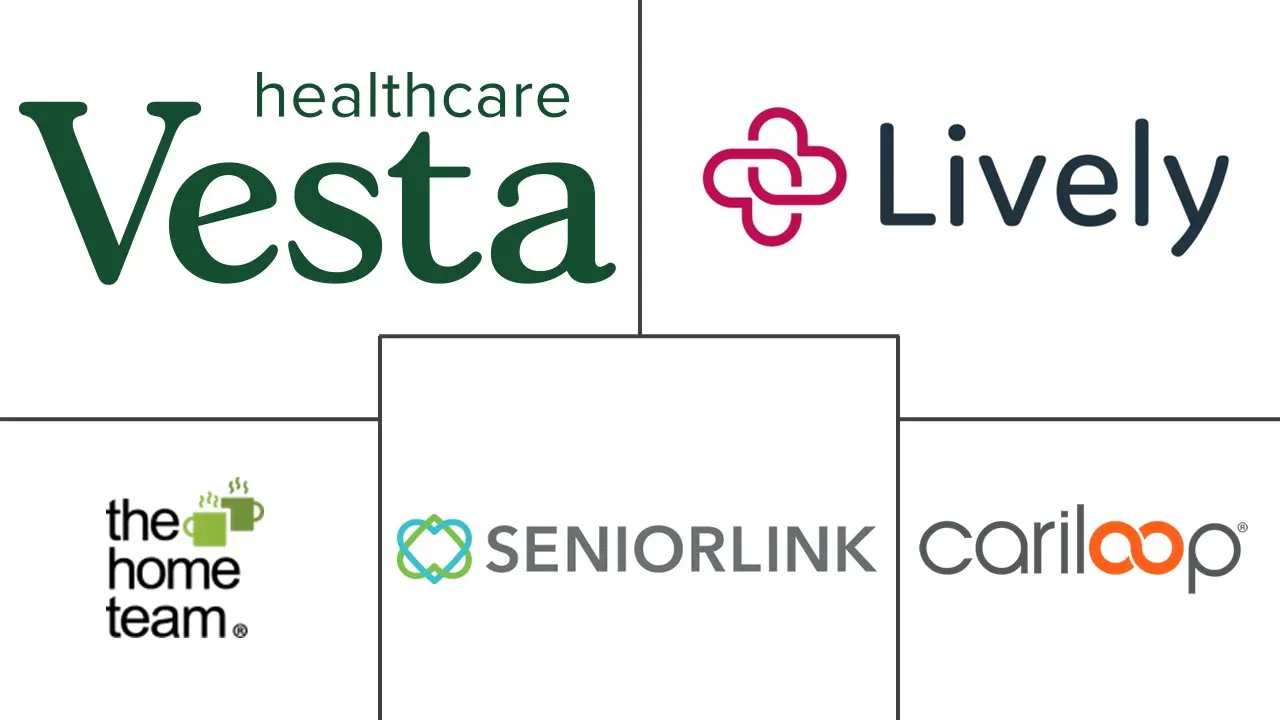Market Size of Global Health Caregiving Industry

| Study Period | 2019 - 2029 |
| Market Size (2024) | USD 204.02 Billion |
| Market Size (2029) | USD 362.71 Billion |
| CAGR (2024 - 2029) | 12.20 % |
| Fastest Growing Market | Asia-Pacific |
| Largest Market | North America |
| Market Concentration | Medium |
Major Players
*Disclaimer: Major Players sorted in no particular order |
Health Caregiving Market Analysis
The Global Health Caregiving Market size is estimated at USD 204.02 billion in 2024, and is expected to reach USD 362.71 billion by 2029, growing at a CAGR of 12.20% during the forecast period (2024-2029).
The health caregiving market was adversely affected by the pandemic. For instance, in November 2021, a report published by the Blue Cross and Blue Shield Association stated that the elevated rate of COVID-related deaths in long-term care facilities exposed inadequacies in the current system and would refocus attention on in-home care. Due to increased regulatory standards and demand, 30% of long-term care facilities could face bankruptcy in the coming years, forcing even more caregiving impact at home and onto unpaid family and friends. Data on the commercially insured population is supplemented with information on the Medicare fee-for-service population to capture caregiving demand among those 65 and older. The result of this analysis was an estimate that nearly 51 million Americans require some form of caregiving. However, there is wide geographic variation in this population, ranging from 11.1% to 20.7% of the total population at the state level. In addition, the market growth is stabilizing in the current scenario after COVID-19 as the worldwide restrictions have eased and various services have been resumed.
The market for health caregiving is being driven by the increase in disposable income, the prevalence of surgery, and technological developments in the field. For instance, according to the PETERSON-KFF Health System Tracker data published in February 2022, the United States' health care spending increased 9.7% to reach USD 4.1 trillion in 2020, a much faster rate than the 4.3% increase seen compared to the previous year. The acceleration in 2020 was due to a 36.0% increase in federal expenditures for health care that occurred largely in response to the COVID-19 pandemic. The private business share of health spending accounted for 16.7% of total health care spending, state and local governments accounted for 14.3%, and other private revenues accounted for 6.5%.
Moreover, in February 2022, Malta became the first country to introduce iSupport, the WHO online training for caregivers of people with dementia. The training that started in Malta is the result of a two-year effort by the Ministry for Senior Citizens and Active Aging, clinicians, academics, civil society organizations, and caregivers of people with dementia to adapt the original WHO version to the Maltese context.
As a result, all of the aforementioned factors are expected to drive market growth during the forecast period. However, the overall fragmented market weakens the service's adoption potential.
Health Caregiving Industry Segmentation
As per scope, health caregiving includes emotional support and help to manage a chronic disease or disability. Caregiving responsibilities can increase and change as the recipient's needs increase. The health caregiving market is segmented by care type (daily essential activities, health and safety awareness, social well-being, and others), end user (geriatric population, disabled population, and others), and geography (North America, Europe, Asia-Pacific, the Middle East and Africa, and South America). The market report also covers the estimated market sizes and trends for 17 countries across major global regions. The report offers a value (USD million) for the above segments.
| By Care Type | |
| Daily Essential Activities | |
| Health and Safety Awareness | |
| Social Well-Being | |
| Others |
| By End User | |
| Geriatric Population | |
| Disabled Population | |
| Others |
| Geography | ||||||||
| ||||||||
| ||||||||
| ||||||||
| ||||||||
|
Global Health Caregiving Market Size Summary
The health caregiving market is poised for significant growth, driven by factors such as increasing disposable income, the prevalence of surgeries, and advancements in technology. The market, which faced challenges during the pandemic, is stabilizing as global restrictions ease and services resume. The demand for caregiving is further fueled by the growing geriatric population, who require enhanced care due to age-related health issues. This demographic shift is particularly pronounced in low- and middle-income countries, where the majority of the elderly population is expected to reside by 2050. The market's expansion is also supported by initiatives like Malta's introduction of WHO online training for dementia caregivers, highlighting the global focus on improving caregiving standards.
North America is anticipated to maintain a significant share of the market, bolstered by high healthcare spending, the prevalence of chronic diseases, and a demand for advanced healthcare services. Public sector initiatives and private investments, such as Honor Technology's acquisition of Home Instead, are key drivers of market growth in the region. The market landscape is partially fragmented, with major players like Vesta Healthcare and Seniorlink, Inc. holding substantial shares. Collaborative efforts, such as those between Wellthy and Point32 Health companies, aim to enhance caregiving management for commercial members, further contributing to the market's development.
Global Health Caregiving Market Size - Table of Contents
-
1. MARKET DYNAMICS
-
1.1 Market Overview
-
1.2 Market Drivers
-
1.2.1 Increasing Online Care Services
-
1.2.2 Growing Burden of Chronic Diseases
-
1.2.3 Increasing Geriatric Population
-
-
1.3 Market Restraints
-
1.3.1 Overall Fragmented Market Weakens Service Adoption Potential
-
-
1.4 Porter's Five Forces Analysis
-
1.4.1 Threat of New Entrants
-
1.4.2 Bargaining Power of Buyers/Consumers
-
1.4.3 Bargaining Power of Suppliers
-
1.4.4 Threat of Substitute Products
-
1.4.5 Intensity of Competitive Rivalry
-
-
-
2. MARKET SEGMENTATION (Market Size by Value - USD million)
-
2.1 By Care Type
-
2.1.1 Daily Essential Activities
-
2.1.2 Health and Safety Awareness
-
2.1.3 Social Well-Being
-
2.1.4 Others
-
-
2.2 By End User
-
2.2.1 Geriatric Population
-
2.2.2 Disabled Population
-
2.2.3 Others
-
-
2.3 Geography
-
2.3.1 North America
-
2.3.1.1 United States
-
2.3.1.2 Canada
-
2.3.1.3 Mexico
-
-
2.3.2 Europe
-
2.3.2.1 Germany
-
2.3.2.2 United Kingdom
-
2.3.2.3 France
-
2.3.2.4 Italy
-
2.3.2.5 Spain
-
2.3.2.6 Rest of Europe
-
-
2.3.3 Asia-Pacific
-
2.3.3.1 China
-
2.3.3.2 Japan
-
2.3.3.3 India
-
2.3.3.4 Australia
-
2.3.3.5 South Korea
-
2.3.3.6 Rest of Asia-Pacific
-
-
2.3.4 Middle-East and Africa
-
2.3.4.1 GCC
-
2.3.4.2 South Africa
-
2.3.4.3 Rest of Middle-East and Africa
-
-
2.3.5 South America
-
2.3.5.1 Brazil
-
2.3.5.2 Argentina
-
2.3.5.3 Rest of South America
-
-
-
Global Health Caregiving Market Size FAQs
How big is the Global Health Caregiving Market?
The Global Health Caregiving Market size is expected to reach USD 204.02 billion in 2024 and grow at a CAGR of 12.20% to reach USD 362.71 billion by 2029.
What is the current Global Health Caregiving Market size?
In 2024, the Global Health Caregiving Market size is expected to reach USD 204.02 billion.

